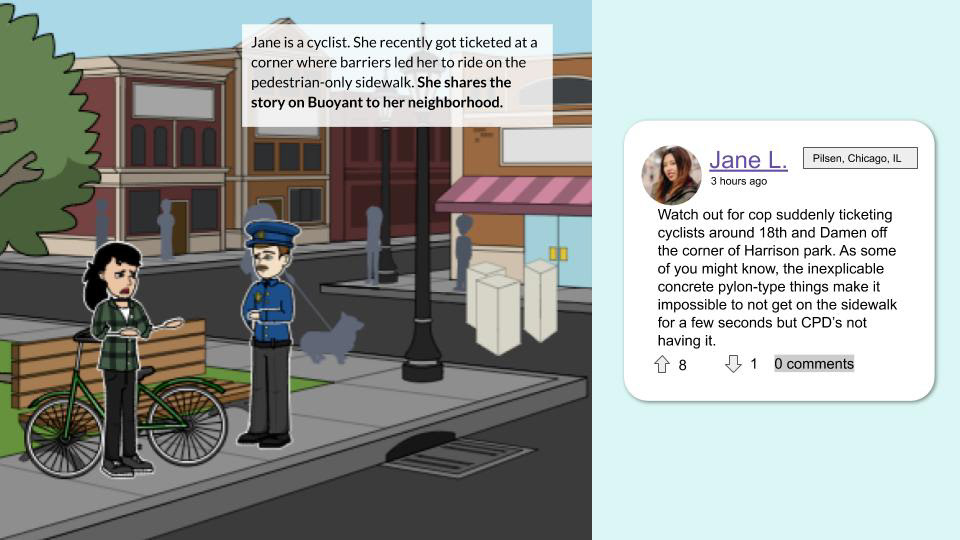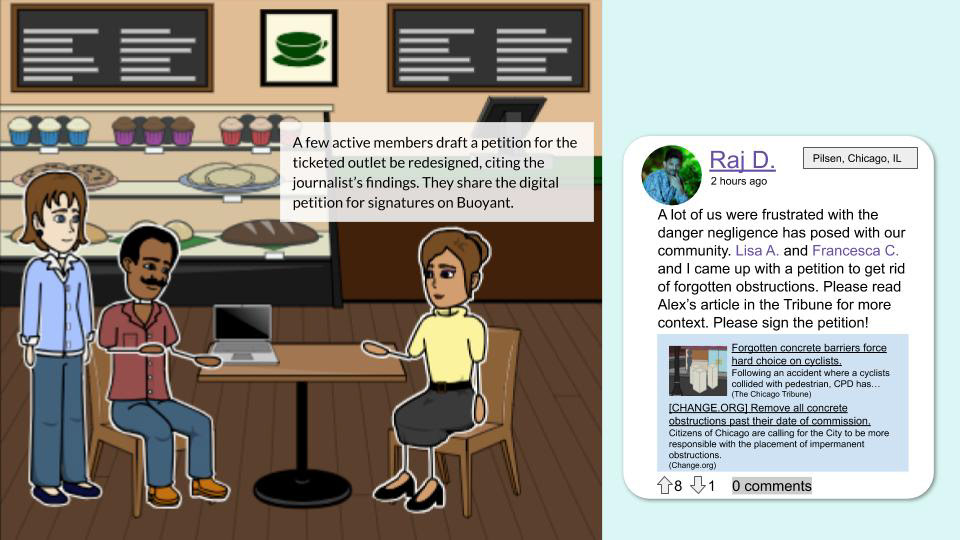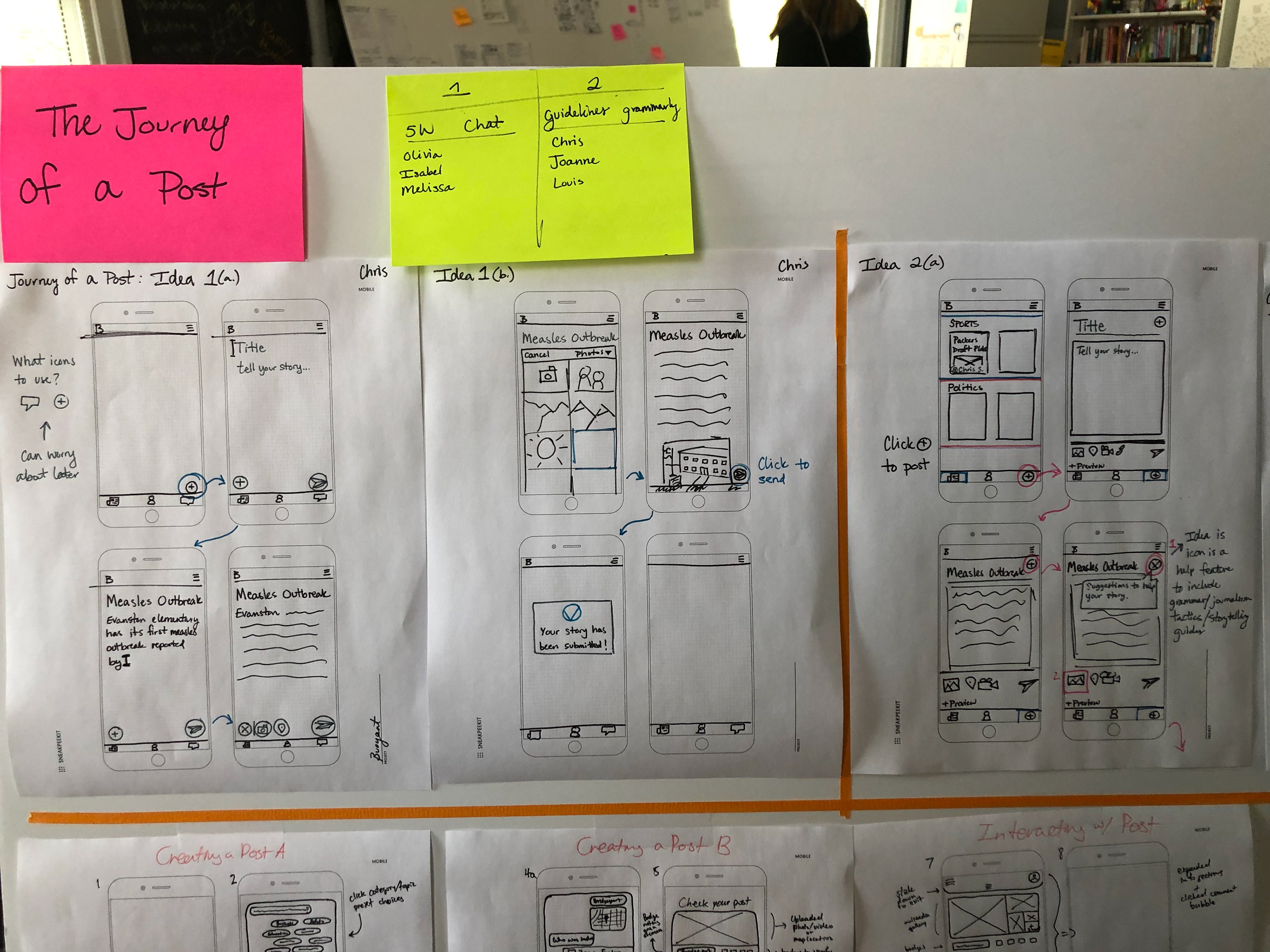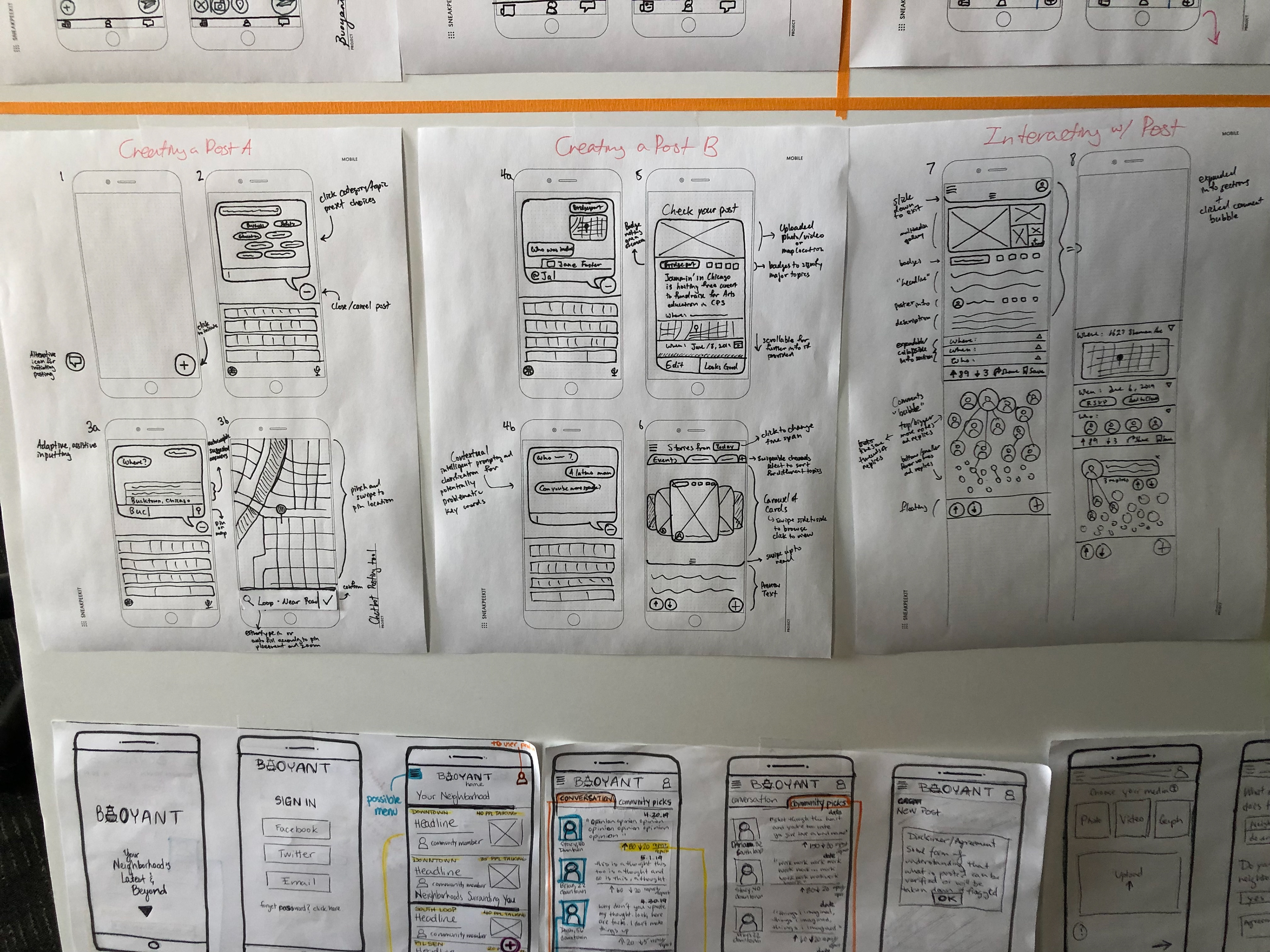Challenge: Imagine and prototype new approaches to local news in order to reconnect people to important information about their communities.
Role and Key Contributions: Project teams were small and tight-knit and there were no specifically delineated roles within teams. Responsibilities were generally equally shared. However, I was especially highly involved with crafting testing protocols and leading the interviews I was on. I was the initial conceiver of the "Buoyant" concept and therefore led storyboarding and the initial feature description. Later, I was primarily responsible for iterating the Buoyant posting experience and most of the prototype designs for it were led by me.
Outcome: Overall, the student research group produced prototypes for two ideas. The team I was in presented "Buoyant," a social network platform designed to encourage users to crowd-source both news and the editorial process with their communities. Our insights and prototype set the groundwork for the next sequence of the Local News Initiative where teams of developers will set out to refine ideas and built a minimum viable product to test in the wild.
From 2004 to 2018, 1 in 5 local papers across the United States have shut down. In many communities, especially those that are rural, poor or older, are especially at risk to become "news deserts." These areas suffered the heaviest losses in journalism and are less likely to be served by digital upstarts. Even regional papers are strapped for resources to properly serve all communities in their range of readership.
The Local News Initiative was launched by Northwestern University at the Medill School with to reinvent the relationship between local news organizations and audiences in the face of widespread news coverage shrinkage and critical disruption of the journalism/media business model. This initiative is grant-funded, multi-pronged and a two-year research and development project.
I was involved in the "phase-2" of the human-centered media product design and development arm of the initiative. The first phase involved field research of news consumers and established an attitudinal framework that would inform the overarching challenges, issues, needs and desires of the users to design products for. I joined a team of graduate journalism (media innovation) and engineering (engineering design) students. The six months had two parts: part one mainly involved the empathizing-defining-ideating stages of the design-thinking process and part two focused on the ideating-prototyping-testing stages of developing ideas.
Part 1: Empathizing, Defining and Ideating(January - March)
Buoyant team share-out at the end of the quarter.
In the first three months, the R&D group was split into three groups of three or four. Each group conducted a range of interviews with newsroom stakeholders and average news consumers in the Chicagoland area. We synthesized insights from these conversations to form an initial composite persona fleshed out with journey and empathy mapping exercises. This allowed us then to identify and contextualize the key problems our persona faces and this became the foundation to brainstorm ideas.
Some key insights that interested us include how many mentioned that they relied on their personal networks the most for local (especially hyperlocal) news. Given the political climate, many had cautious or suspicious attitudes towards national sources despite turning to them the most. Many did recognize the lack of trustworthy sources for local information. While most considered being informed about their local communities to be important, many were at loss as to how to remedy that gap. Some had turned to neighborhood Facebook groups but faced issues such as toxic behaviors like racism, the lack of content moderation and broader experience problems that Facebook had given the recent revelations on fake news.
After several rounds of ideation, concept development, concept testing and team feedback, we focused our attention towards an idea we dubbed "Buoyant." It aimed to take advantage of The following is an initial feature description of our idea:
Buoyant is where Nextdoor meets Reddit. It is a social platform for people to inform each other in their neighborhood and take control of sharing and curating local stories and news collectively with their community.
1. With Buoyant, you share and curate local stories and news collectively with your neighborhood.
2. With Buoyant, you engage with your neighborhood in a brand new way. You and your neighbors are in control of creating the culture of your local Buoyant news feed, where important local stories and news are floated up based on votes from you and your neighbors while the other information sink. No more overwhelming or irrelevant news feed.
3. With Buoyant, you are informed about top stories and news from other neighborhoods, curated by specific neighborhoods themselves. Other neighborhoods will also be informed about your top local stories and news curated and voted by you and your neighborhood.
4. If you are a local journalist, you have the opportunity to moderate your local Buoyant news feed and understand the real-time view of the local concerns and interests to provide your readers with valuable news articles.
Below, you can find the storyboard I created with my team to illustrate the way "Buoyant" would be used.





Part 2: Prototyping, Testing... and Repeat (April - June)
Three concepts were developed and shared at the end of part 1. Among them, two made it into the next quarter for further prototyping and testing. Buoyant was one of those two. With a bigger team and new members, the next three months focused on creating low-fidelity iterations and continued refining of our user personas.
We started the quarter by studying UX patterns and refining and developing our user personas through concept testing. We found that the most critical type of user was the sharer. These types are usually the minority among all users but are those who populate social network platforms with information and are therefore those who breathe value into the platform. While we had expected journalists to be the exemplification of this type, we found that they were more hesitant and calculating in their involvement. Instead, we found community organizers to be the most willing and leading users in bringing value at the local level. Their involvement within communities also made them central nodes in neighborhood networks and could potentially be shepherds for gaining user buy-in.
Because of the nature of our proposed solution, many users offered feedback in terms of how the status quo failed. Email newsletters were often difficult for organizers to view and encourage engagement or interaction. Nextdoor often became markets rather than forums and had a limited definition of local. Facebook was hard to parse for valuable information or fomented drama. We tried to focus on developing unique posting experiences and feed-customizing experiences that would encourage quality posting, interactions and relevance for our users.




For six weeks, we conducted several rounds of feature prototyping, testing and iteration. We split our efforts between two subgroups to tackle two of the key aspects of the product: the feed and posting. I was part of the latter and created several iterations, starting from interactive simulations on Google Slides to verbal testing with Adobe XD prototypes.
After multiple iterations, we presented our findings and a final demo of Buoyant's key features.


